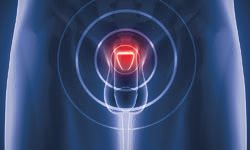18F-rhPSMA-7.3 Increases Upstaging of Disease in Recurrent Prostate Cancer
Use of 18F-rhPSMA-7.3 PET results in post-scan upstaging compared with conventional imaging in patients with prostate cancer recurrence.

Findings from the phase 3 SPOTLIGHT trial (NCT04186845) show that PET/CT scans conducted with 18F-rhPSMA-7.3 result in post-scan upstaging compared with conventional imaging in patients with prostate cancer recurrence, according to updated data presented at the 2022 AUA Annual Meeting.
Among 250 of 366 men in the efficacy analysis population who had negative baseline conventional imaging, 18F-rhPSMA-7.3 showed a correct detection rate between 45% and 47%, which is the percentage of patients scanned with at least one true positive PET finding compared with the Standard of Truth of histopathology or confirmatory conventional imaging. Notably, upstaging results were found to vary based on prior treatment and anatomical region.
18F-rhPSMA-7.3 is an investigational prostate‐specific membrane antigen (PSMA)–targeted radiohybrid (rh) PET imaging agent. The agent has a longer half-life, a scope for larger batch productions, and improved spatial resolution in PET images compared with gallium 68.
Prior data from SPOTLIGHT presented at the 2022 Genitourinary Cancers Symposium showed that the overall detection rate in patients who had an evaluable 18F-rhPSMA-7.3 scan was 83% by majority read.3
SPOTLIGHT enrolled male patients who were at least 18 years of age and received prior curative intent treatment for localized prostate cancer. Patients were required to have elevated PSA that could indicate biochemical recurrence and be eligible for salvage therapy.
18F-rhPSMA-7.3 was administered at a dose of 296 MBq/8 mCi, and PET/CT scans were given between 50 and 70 minutes following injection. Scans were then evaluated by 3 blinded central readers. The Standard of Truth was histopathology or confirmatory conventional imaging. Biopsies took place with 60 days following PET scans, and confirmatory imaging was conducted within 90 days.
Of the 420 patients who consented for the trial, 391 received 18F-rhPSMA-7.3, of which 389 underwent an evaluable PET/CT scan. Furthermore, 366 patients had sufficient data to determine Standard of Truth; these patients comprised the efficacy-evaluable population. Specifically, 69 patients had Standard of Truth determined by histopathology compared with imaging in 297 patients.
In this population, the mean age was 68.4 years (range, 43-85). The median PSA was 1.27 ng/mL (range, 0.03-134.6), and most patients had a Gleason grade group of 3 (30%).
Additional data showed the 18F-rhPSMA-7.3 detection rate was 88% compared with a correct detection rate of 57%.
In patients with negative baseline conventional imaging in the prostate bed region, between 3.5% and 8.0% of patients post prostatectomy showed true positive detections compared with between 39% and 41% of patients post radiation therapy.
In patients with negative baseline conventional imaging in the pelvic lymph node region, between 18% and 21% of patients post prostatectomy showed true positive detections vs 6.5% of patients post radiation. In patients with negative baseline conventional imaging in the extra-pelvic region, between 21% and 26% of patients post prostatectomy showed true positive detections vs between 20% and 30% of patients post radiation.
“It was very interesting for me, as you look closer to the data, that patients who had prostatectomy [were] different than patients who had radiation in the sites of disease,” Fleming said.
Based on the updated data from SPOTLIGHT, 18F-rhPSMA-7.3 could represent a way to better define sites of disease recurrence and identify salvage therapies for the right patients.
“[SPOTLIGHT] showed that we are able to upstage patients [with 18F-rhPSMA-7.3], that we are able to find disease that was missed [by conventional imaging] and gave a false sense of reassurance to patients that they didn’t have recurrence of the disease,” Fleming concluded.
References
Fleming MT. Impact of 18F-rhPSMA-7.3 PET on upstaging of patients with prostate cancer recurrence: results from the prospective, phase 3, multicenter, SPOTLIGHT study. Presented at: 2022 AUA Annual Meeting; May 13-16, 2022; New Orleans, LA. Abstract PLLBA-02.
Blue Earth Diagnostics announces additional results from phase 3 SPOTLIGHT trial of investigational PET imaging agent 18F-rhPSMA-7.3 in biochemical recurrence of prostate cancer. News release. Blue Earth Diagnostics. May 13, 2022. Accessed May 13, 2022. https://bwnews.pr/3wu1Cr9
Schuster DM. Detection rate of 18F-rhPSMA-7.3 PET in patients with suspected prostate cancer recurrence: results from a phase 3, prospective, multicenter study (SPOTLIGHT). J Clin Oncol. 2022(suppl 6):9. doi:10.1200/JCO.2022.40.6_suppl.009